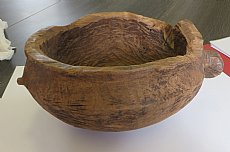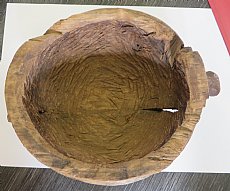Wooden Bowl from Loch a’ Ghlinne Bhig, Bracadale, Skye
02 January 2020
- News Type:
- Find of the Month
 This wooden bowl was discovered sometime between 1979-1981 during the construction of a forestry road to the north of the Struan road, by Loch a’ Ghlinne Bhig. It is a roughly circular, round-bottomed vessel with a pronounced shoulder (carination) and everted rim. A short stud projects from the exterior on one side and opposite to this is a prominent lug which serves as a handle. Overall, the bowl stands to a height of 115mm, measures 188mm in diameter at its rim and 213mm in diameter at its shoulder.
This wooden bowl was discovered sometime between 1979-1981 during the construction of a forestry road to the north of the Struan road, by Loch a’ Ghlinne Bhig. It is a roughly circular, round-bottomed vessel with a pronounced shoulder (carination) and everted rim. A short stud projects from the exterior on one side and opposite to this is a prominent lug which serves as a handle. Overall, the bowl stands to a height of 115mm, measures 188mm in diameter at its rim and 213mm in diameter at its shoulder.
 The bowl was carved from a very knotty piece of alder, which may account for the vessel’s eccentric shape, in addition to the effects of it drying out following its discovery. The bowl is clearly unfinished; its exterior is relatively well shaped but its interior bears rough tool marks with sharp edges, creating a rosette pattern at the base of the bowl. Since the wood is still splintered around the tool marks, it is unlikely that the bowl was ever used as these splinters would not have survived otherwise. The shape of the marks allows for some reconstruction of its creation by the wood carver, such as the tools used and the angling of the bowl as is it was worked. The following manufacture sequence has been suggested:
The bowl was carved from a very knotty piece of alder, which may account for the vessel’s eccentric shape, in addition to the effects of it drying out following its discovery. The bowl is clearly unfinished; its exterior is relatively well shaped but its interior bears rough tool marks with sharp edges, creating a rosette pattern at the base of the bowl. Since the wood is still splintered around the tool marks, it is unlikely that the bowl was ever used as these splinters would not have survived otherwise. The shape of the marks allows for some reconstruction of its creation by the wood carver, such as the tools used and the angling of the bowl as is it was worked. The following manufacture sequence has been suggested:
- Initial shaping of the wood with an axe
- Careful shaping of the exterior, likely with a shallow gouge with a cutting edge 10-12mm wide
- Removal of the interior, with a small axe 40mm wide at its cutting edge, to a depth of 70mm
Given the contrast between the rough-hewn interior and finished exterior (which bears ornamentation of shallow grooves parallel to the carination on it lower half and vertically aligned facets to the neck), it is highly likely that the bowl was abandoned before it completion. It is part of a small group of wooden bowls known from Scotland, one of which was found only a few kilometres away at Talisker Moor. This example has notable similarities, being of the same shape and style with similar ornamentation and is also made of alder. The only major difference between these two bowls is that the Talisker Moor example has two finely shaped handles, whereas the bowl from Loch a’ Ghlinne Brig has only one. It had been suggested that this single handle, the stud on the opposite side and the bowl’s wide, flat rim may have been intended to bear a lid. Both bowls have been radiocarbon dated to the Iron Age (20-125 AD and 85-245 AD calibrated to 1 sigma).
The Loch a’ Ghlinne Bhig bowl is an important object as wooden vessels from this period rarely survive. Its shape clearly indicates a different function to the flat bottomed ceramic vessels that are contemporary on Skye, reflecting the selection of different materials for different functional styles. Furthermore, the unfinished status of the bowl offers a rare insight into the manufacture techniques used to produce these objects. Given the morphological and stylistic similarities of this bowl and the proximity of the example from Talisker Moor, it is possible that they are product of the same workshop. Neither appears to have been found in the context of any site, and they both therefore likely represent objects lost by individuals during the Iron Age. This would perhaps also account for the unfinished nature of the Loch a’ Ghlinne Bhig example.
The Bracadale bowl is held by the Skye and Lochalsh Archive Centre (Acc. No 1990.7).
Further Information
Highland HER record: https://her.highland.gov.uk/Monument/MHG6718
Crone, B. A. 1993. ‘A wooden bowl from Loch a' Ghlinne Bhig, Bracadale, Skye,' Proceedings of the Society of Antiquaries of Scotland 123, 269-75. (Available online)
See also
https://her.highland.gov.uk/Monument/MHG5036 (Talisker Moor Bowl HER Record)
Report contributed by Grace Woolmer
Find of the Month Archive
- 25/07/2022 Steatite Vessels
- 10/04/2021 Cruisie lamp in Dunrobin Castle Museum
- 02/03/2021 Medieval Sword Pommel from Sleat, Skye
- 01/02/2021 Hilton of Cadboll Pictish Cross Slab
- 04/01/2021 Gunflint from Stoneyfield, Inverness
- 02/12/2020 Bobbin from Contin Bobbin Mill
- 02/11/2020 Russian Lead Cloth Seal from Cromarty
- 01/10/2020 The Poolewe Hoard
- 04/09/2020 Storr Rock Viking Silver Hoard
- 07/08/2020 Mesolithic bloodstone artefacts from Camas Daraich, Skye
